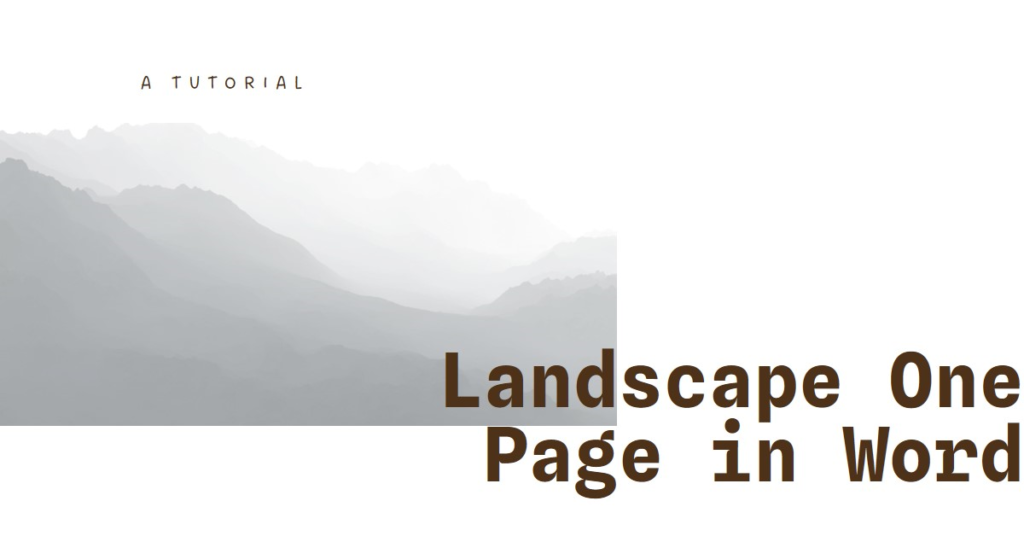
Table of Contents
- Introduction
- Understanding Page Orientation in Word
- Preparing Your Document
- Inserting Section Breaks
- Changing the Page Orientation
- Ensuring Proper Content Alignment
- Adding Section Breaks to Return to Portrait Orientation
- Troubleshooting Common Issues
- Saving and Reviewing Your Document
- Practical Applications of Landscape Pages
- Conclusion: Enhancing Document Presentation
Introduction
Microsoft Word, a powerful word processing tool, offers a plethora of features to enhance your document’s presentation. One such feature is the ability to change the orientation of a single page to landscape while keeping the rest of the document in portrait mode. This tutorial will guide you through the steps necessary to achieve this. Whether you need to include a wide table, a large image, or simply prefer the aesthetics of a landscape page, this guide will make the process straightforward and manageable.
Understanding Page Orientation in Word
Before diving into the steps, it’s essential to understand what page orientation means. In Word, you have two orientation options: portrait and landscape. Portrait orientation is vertical, typically used for standard documents and letters, while landscape orientation is horizontal, ideal for wide tables, charts, or images.
By default, Word documents are set to portrait orientation. However, Word’s flexibility allows you to mix both orientations within a single document, which can significantly enhance the document’s visual appeal and functionality.
Preparing Your Document
Before changing the orientation of a specific page, it’s wise to prepare your document. Ensure you save a backup copy to avoid any unintended changes. Open your document and navigate to the page you want to change. Having a clear plan for which page requires landscape orientation will make the process smoother.
Moreover, familiarize yourself with the content on the page you wish to change. Identify any elements that might need adjusting once the orientation changes, such as images, tables, or text boxes. This preparation will help you anticipate any adjustments needed post-orientation change.
Inserting Section Breaks
To change the orientation of a single page, you’ll need to use section breaks. Section breaks allow you to apply different formatting to different parts of your document. Follow these steps to insert a section break:
- Place your cursor at the end of the page before the one you want to change.
- Go to the Layout or Page Layout tab.
- Click on Breaks and select Next Page under the Section Breaks section.
This step creates a new section starting on the next page, allowing you to apply different formatting settings.
Changing the Page Orientation
With the section break in place, you can now change the orientation of the desired page. Here’s how:
- Place your cursor on the page you want to change.
- Go to the Layout or Page Layout tab.
- Click on Orientation and select Landscape.
You’ll notice that the orientation of your selected page has changed to landscape. This change will only affect the page within the new section created by the section break.
Ensuring Proper Content Alignment
After changing the page orientation, it’s crucial to check the alignment of your content. Elements like text, tables, and images might need realignment or resizing to fit the new orientation. Here are some tips to ensure proper alignment:
- Text Alignment: Adjust text boxes and ensure the text is within the margins.
- Tables: Resize columns and rows to fit within the landscape layout.
- Images: Scale images proportionally to avoid distortion and ensure they fit within the margins.
Taking these steps will ensure your content looks polished and professional in landscape orientation.


Adding Section Breaks to Return to Portrait Orientation
Once you’ve changed the page to landscape, you may need to revert to portrait orientation for the following pages. To do this, you’ll insert another section break:
- Place your cursor at the end of the landscape-oriented page.
- Go to the Layout or Page Layout tab.
- Click on Breaks and select Next Page under the Section Breaks section.
This creates a new section, allowing you to change the orientation of subsequent pages back to portrait.
Troubleshooting Common Issues
Even with careful preparation, you might encounter some common issues when changing page orientation. Here’s how to address them:
- Content Overflow: If your content spills over the page margins, adjust the size of tables, images, or text boxes.
- Unexpected Section Breaks: Ensure section breaks are placed correctly to avoid unexpected formatting changes.
- Header and Footer Discrepancies: If headers and footers differ between sections, ensure they are linked properly by checking the “Link to Previous” option in the Header & Footer Tools.
By troubleshooting these issues promptly, you can maintain a professional-looking document.
Saving and Reviewing Your Document
After making the necessary changes, save your document. It’s a good practice to review the entire document to ensure the formatting is consistent and professional. Pay close attention to the sections where the orientation changes occur to ensure a seamless transition between portrait and landscape pages.
Practical Applications of Landscape Pages
Understanding when and why to use landscape orientation can enhance your document’s effectiveness. Here are a few scenarios where landscape orientation is particularly useful:
- Wide Tables: Landscape orientation accommodates wider tables that cannot fit in portrait mode.
- Large Images and Charts: Use landscape for large images, graphs, or charts to display them more clearly.
- Design Layouts: Landscape pages can enhance the design and layout of brochures, flyers, or presentations.
By strategically using landscape orientation, you can improve the readability and visual appeal of your documents.
Conclusion: Enhancing Document Presentation
Mastering the skill of changing page orientation in Word can significantly enhance your document’s presentation. By following the steps outlined in this tutorial, you can effortlessly switch between portrait and landscape orientations, ensuring your content is displayed in the most effective way possible. Remember, the key to a professional document is not just the content but also how it is presented. With practice, you’ll be able to create visually appealing and well-organized documents that stand out.
Incorporating landscape orientation into your Word documents is a valuable skill for anyone looking to elevate their document formatting. Whether you are preparing a report, a proposal, or a presentation, understanding how to landscape a single page will add a professional touch to your work.


